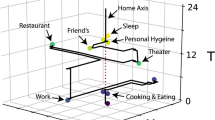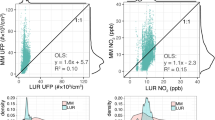Abstract
A prospective personal exposure study, involving indoor and outdoor releases, was conducted in upper Midtown Manhattan in New York City as part of the Urban Dispersion Program (UDP) focusing on atmospheric dispersion of chemicals in complex urban settings. The UDP experiments involved releases of very low levels of perfluorocarbon tracers (PFTs) in Midtown Manhattan at separate locations, during two seasons in 2005. The study presented here includes both outdoor and indoor releases of the tracers, and realistic scripted activities for characterizing near source and neighborhood-scale exposures using 1-min and 10-min duration samples, respectively. Results showed that distributions of individual tracers and exposures to them within the study area were significantly influenced by surface winds, urban terrain, and movements of people typical of urban centers. Although in general, PFT levels returned quickly to zero in general after cessation of the emissions, in some cases, the concentrations stayed at higher levels after the releases stopped. This is likely due to accumulation of the PFTs in some buildings, which then serve as “secondary sources” when outside levels are lower than indoor levels. Measurements of neighborhood-scale PFT concentrations (up to distances of several blocks away from the release points) provided information needed to establish a baseline for determining how different types of releases could affect exposures both to the general public and to emergency responders. These data highlight the factors impacting the toxic threat levels following releases of hazardous chemicals and provide supporting information for evaluating and refining protocols for emergency event response.
This is a preview of subscription content, access via your institution
Access options
Subscribe to this journal
Receive 6 print issues and online access
$259.00 per year
only $43.17 per issue
Buy this article
- Purchase on Springer Link
- Instant access to full article PDF
Prices may be subject to local taxes which are calculated during checkout







Similar content being viewed by others
References
Allwine K, Shinn J, Streit G, Clawson K, Brown M . Overview of URBAN 2000. B Am Meteorol Soc 2002; 83: 521–536.
Allwine KJ, Leach M, Stockham L, Shinn J, Hosker R, Bowers J et al. (Eds. Overview of Joint Urban 2003—An Atmospheric Dispersion Study in Oklahoma City 2004.
Allwine KJ, Flaherty JE . Urban Dispersion Program Overview and MID05 Field Study Summary. Pacific Northwest National Laboratory (PNNL): Richland, WA, USA. 2007.
Martin D, Nickless G, Price CS, Britter RE, Neophytou MK, Cheng H et al. Urban tracer dispersion experiment in London (DAPPLE) 2003: field study and comparison with empirical prediction. Atmos Sci Lett 2010; 11: 241–248.
Martin D, Price CS, White IR, Nickless G, Petersson KF, Britter RE et al. Urban tracer dispersion experiments during the second DAPPLE field campaign in London 2004. Atmos Environ 2010; 44: 3043–3052.
Lioy PJ, Vallero D, Foley G, Georgopoulos P, Heiser J, Watson T et al. A personal exposure study employing scripted activities and paths in conjunction with atmospheric releases of perfluorocarbon tracers in Manhattan, New York. J Exp Sci Environ Epidemiol 2007; 17: 409–425.
Richmond-Bryant J, Isukapalli SS, Vallero DA . Air pollutant retention within a complex of urban street canyons. Atmos Environ 2011; 45: 7612–7618.
Hanna S, White J, Zhou Y . Observed winds, turbulence, and dispersion in built-up downtown areas of Oklahoma City and Manhattan. Bound-Lay Meteorol 2007; 125: 441–468.
Flaherty JE, Lamb B, Allwine KJ, Allwine E . Vertical tracer concentration profiles measured during the Joint Urban 2003 dispersion study. J Appl Meteorol Clim 2007; 46: 2019–2037.
Urban JT, Warner S, Platt N, Heagy JF . Assessment of HPAC urban modelling capabilities using data from the Joint Urban 2003 field experiment. Int J Environ Pollut 2011; 44: 24–31.
Hanna S, White J, Trolier J, Vernot R, Brown M, Gowardhan A et al. Comparisons of JU2003 observations with four diagnostic urban wind flow and Lagrangian particle dispersion models. Atmos Environ 2011; 45: 4073–4081.
Tewari M, Kusaka H, Chen F, Coirier WJ, Kim S, Wyszogrodzki AA et al. Impact of coupling a microscale computational fluid dynamics model with a mesoscale model on urban scale contaminant transport and dispersion. Atmos Res 2010; 96: 656–664.
Hanna S, Baja E . A simple urban dispersion model tested with tracer data from Oklahoma City and Manhattan. Atmos Environ 2009; 43: 778–786.
Hendricks EA, Diehl SR, Burrows DA, Keith R . Evaluation of a fast-running urban dispersion modeling system using Joint Urban 2003 field data. J Appl Meteorol Clim 2007; 46: 2165–2179.
Flaherty JE, Stock D, Lamb B . Computational fluid dynamic simulations of plume dispersion in urban Oklahoma City. J Appl Meteorol Clim 2007; 46: 2110–2126.
Watson TB, Heiser J, Kalb P, Dietz RN, Wilke R, Weiser R et al. The New York City Urban Dispersion Program March 2005 Field Study: Tracer Methods and Results (Report). Brookhaven National Laboratory. 2006 Report No.: BNL-75552-2006.
NOAA. Air Resources Laboratory. Atmospheric tracer safety. National Oceanic and Atmospheric Administration (NOAA) 2011 [cited 2 March 2011]; Available from: http://www.noaa.inel.gov/capabilities/tracers/tracersafety.htm.
Simmonds PG, Greally BR, Olivier S, Nickless G, Cooke KM, Dietz RN . The background atmospheric concentrations of cyclic perfluorocarbon tracers determined by negative ion-chemical ionization mass spectrometry. Atmos Environ 2002; 36: 2147–2156.
Dietz RN . Perfluorocarbon tracer technology. In: Sandroni S ed. Regional and Long-Range Transport of Air Pollution. Elsevier: Amsterdam. 1987,, 215–247.
Watson TB, Wilke R, Dietz RN, Heiser J, Kalb P . The atmospheric background of perfluorocarbon compounds used as tracers. Environ Sci Technol 2007; 41: 6909–6913.
Hanna SR, Brown MJ, Camell FE, Chan ST, Coirier WJ, Hansen OR et al. Detailed simulations of atmospheric flow and dispersion in downtown Manhattan: an application of five computational fluid dynamics models. B Am Meteorol Soc 2006; 87: 1713–1726.
Zheng MH, Guo YR, Ai XQ, Qin T, Wang Q, Xu JM . Coupling GIS with CFD modeling to simulate urban pollutant dispersion. In:. Proceedings of the 2010 International Conference on Mechanic Automation and Control Engineering (MACE) 2010 Jun 26-28; Wuhan, China. IEEE; 2010 p. 1785–1788.
Long KJ, Zajaczkowski FJ, Haupt SE, Peltier LJ . Modeling a hypothetical chlorine release on a college campus. J Comp 2009; 4: 881–890.
Hanna SR, Hansen OR, Ichard M, Strimaitis D . CFD model simulation of dispersion from chlorine railcar releases in industrial and urban areas. Atmos Environ 2009; 43: 262–270.
Huber A, Georgopoulos P, Gilliam R, Stenchikov G, Wang S-W, Kelly B et al. Modeling air pollution from the collapse of the World Trade Center and assessing the potential impacts on human exposures. Environ Manager 2004, 35–40.
Vallero D . Air pollution chemodynamics. In: Vallero D (ed.). Fundamentals of Air Pollution 4th edn. Elsevier Academic Press: Amsterdam. 2008.
Acknowledgements
We are grateful to John Heiser and his colleagues at BNL, who not only carefully analyzed the samples for PFTs, but who helped to design the quality assurance project plan and otherwise provided invaluable advice on the design and implementation of this study. We also recognize Jim Daloia and this crew of volunteers from the US EPA New York Regional Office, who collected the samples as they walked the routes in and around RC. Finally, we thank Paul Lioy of EOHSI for his leadership in this project and his reliable and sage advice before, during and after this study.
Disclaimer
The United States Environmental Protection Agency through its Office of Research and Development (ORD) partially funded and collaborated in the research described here under assistance agreement CR 83162501 to the Environmental and Occupational Health Sciences Institute, and funded the PFT analyses under contract EPD 04068 with Battelle Memorial Institute and its subcontractor, BNL. The research and the manuscript have been subjected to Agency review and approved for publication.
Author information
Authors and Affiliations
Corresponding author
Ethics declarations
Competing interests
The authors declare no conflict of interest.
Rights and permissions
About this article
Cite this article
Vallero, D., Isukapalli, S. Simulating real-world exposures during emergency events: studying effects of indoor and outdoor releases in the Urban Dispersion Program in upper Manhattan, NY. J Expo Sci Environ Epidemiol 24, 279–289 (2014). https://doi.org/10.1038/jes.2013.38
Received:
Revised:
Accepted:
Published:
Issue Date:
DOI: https://doi.org/10.1038/jes.2013.38



